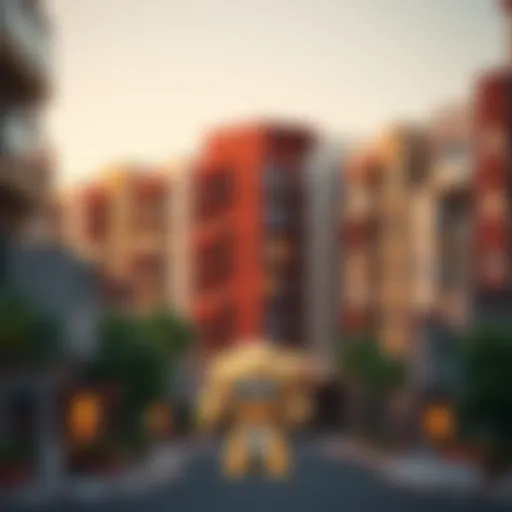Discover Karama Souk: Tradition Meets Modern Shopping
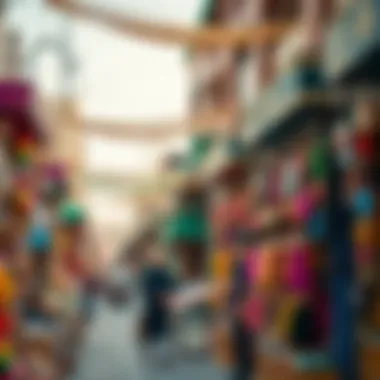
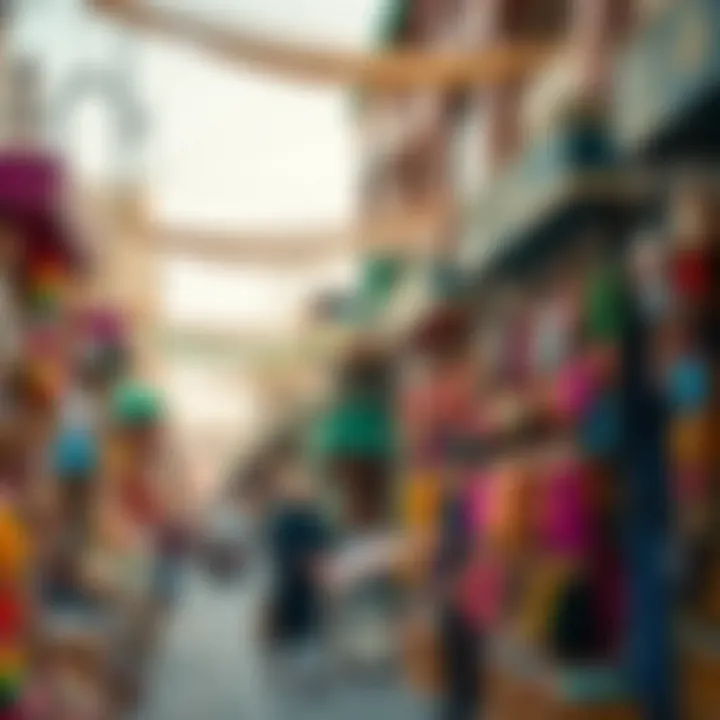
Intro
Nestled in the heart of Dubai, Karama Souk stands as a remarkable testament to the city’s dynamic blend of historical charm and forward-thinking modernity. The souk encapsulates the essence of traditional Arabian bazaars, inviting visitors into a labyrinth of narrow alleyways and vibrant storefronts. Here, the rich aromas of spice waft through the air, mingling with the chatter of vendors and shoppers, creating a sensory experience like no other.
Yet, it’s not just a treasure trove of unique crafts and eats that make Karama Souk a must-visit for both residents and tourists; it symbolizes a deeper narrative about Dubai's evolving identity. The marketplace has transformed over the years, reflecting shifts in societal values and consumer habits, which has significant implications for those looking to understand or invest in Dubai’s ever-changing property landscape.
In this exploration, we will delve into the cultural and economic significance of Karama Souk, shedding light on the factors driving its relevance in today’s market. Investors, agents, developers, and buyers will gain valuable insights into the dynamics at play in this particular region of Dubai, setting the stage for informed decisions about property investments in the area.
Prologue to Karama Souk
Karama Souk serves as a living tapestry of Dubai's soul, weaving together the city’s rich traditions and its dynamic modernization. This marketplace is not just a collection of shops; it's a cultural hub where the past and future come together in a vibrant display. Understanding the essence of Karama Souk is vital for several reasons.
Firstly, it showcases local craftsmanship. The souk is a treasure trove of unique items, ranging from traditional textiles to intricate handicrafts. For investors exploring the craft market, this presents an opportunity to tap into the growing demand for artisanal products that reflect authentic heritage.
Secondly, Karama Souk is steeped in historical significance. Shopping here is more than just a commercial activity; it's a journey through time. By examining its evolution, stakeholders can gain insights into consumer behavior patterns and local sentiments, essential for making informed investment decisions.
Moreover, the souk acts as a melting pot of cultures. A mix of locals and tourists meander through its bustling alleys, fostering a community spirit and enhancing social interaction. Acknowledging this diversity can help businesses and developers shape their offerings to resonate with a broader audience.
Understanding the nuances of Karama Souk is indispensable, regardless if you're a buyer, investor, or stakeholder. Its unique blend of tradition and modernity makes it a captivating focal point in Dubai’s ever-evolving landscape, presenting ample opportunities for growth and engagement.
"At Karama Souk, each corner tells a story that reflects the heartbeat of Dubai—a city constantly in motion yet deeply rooted in its heritage."
In summary, this introductory overview lays the groundwork for a deeper exploration of Karama Souk. As we delve into its history, culture, and economic impact, the significance of this marketplace within Dubai will become increasingly evident.
Historical Background
The historical context of Karama Souk is more than just a backstory; it lays the groundwork for understanding the dynamic intersection of tradition and modernity that defines this marketplace today. Knowledge of its origins and evolution provides crucial insights into how local culture and commercial practices have shaped this bustling hub in Dubai, making it essential for investors, property developers, and stakeholders in the real estate sector. Recognizing the deep roots of this souk allows one to appreciate its significance better, not only as a shopping destination but also as a reflection of the transformations experienced by Dubai as a whole.
Origins of Karama Souk
Karama Souk emerged in the latter part of the 20th century, during a period when Dubai was beginning to blossom as a commercial center in the Gulf region. Initially, this souk catered primarily to local residents. It is said that traders from various communities converged here, bringing with them goods ranging from textiles to spices. This was not merely a commercial venture; it was a social meeting point where neighbors exchanged news, stories, and goods.
As the name "Karama" suggests, which translates to "dignity" in Arabic, the souk symbolizes more than just economic activity; it echoes a cultural essence that has characterized the neighborhood through decades. Unlike other high-end shopping venues that sprang up in Dubai, Karama Souk retained its focus on providing affordable products, making it a beloved shopping locale for both Emiratis and expatriates. Not only did it fulfill practical needs, but it also became emblematic of the spirit of community that often gets overshadowed by the rapid urban development surrounding it.
Evolution Over the Decades
Over the decades, the evolution of Karama Souk has mirrored the metamorphosis of Dubai itself. In the early days, as noted, the souk primarily served local residents with its mix of crafts and everyday goods. However, as Dubai gained international prominence, especially in the tourism and real estate sectors, the souk underwent a subtle transformation.
In the 1990s and 2000s, the area started seeing an influx of tourists and newer residents. Business owners adapted their offerings, incorporating more diverse products, including souvenirs and gifts that catered to the increasing demand. This shift was crucial as it marked a blending of authentic Emirati culture with global influences.
"Karama Souk is not just a place to shop; it’s a snapshot of Dubai's journey from a trading post to a global metropolis."
To keep up with the competitive retail landscape, many vendors also embraced e-commerce. Now, some shops offer online platforms alongside their physical stores. So, not only did the souk preserve its identity, but it also embraced modern marketing techniques, allowing it to remain relevant in a rapidly changing economy.
While the character of Karama Souk has undoubtedly shifted over the years, the underlying spirit hasn’t changed. It remains a vibrant area filled with stories from its roots that continue to resonate with new generations. This blend of rich tradition with contemporary advancements makes Karama Souk an intriguing subject for anyone looking to understand the socio-economic narratives of Dubai.
In a city that is frequently tied to luxury and excess, Karama Souk acts as a reminder that the heart of Dubai beats with the stories and traditions of its past, making it a focal point worth exploring for visitors and stakeholders alike.
More information about the history of Dubai can be found at Britannica and for insights into souk culture, refer to Wikipedia.
The nuances of this historical backdrop provide valuable context for understanding the ongoing transformation in Karama Souk and its impact on local investment opportunities.
Cultural Significance
The cultural significance of Karama Souk extends beyond its status as a mere shopping destination. It is a living tapestry that weaves together the threads of tradition, heritage, and communal life in Dubai. This market serves as a microcosm of the broader cultural landscape of the UAE, making it essential for understanding both historical and contemporary dynamics. Visitors do not just come to shop; they come to experience the very essence of local life. This is where the aromas of spices mingle with the sounds of bargaining, and where every stall tells a story of its own.
Reflecting Local Traditions
Karama Souk stands as a beacon of local traditions, vibrant with the authenticity of Emirati culture. Walking through its narrow alleys is akin to taking a step back in time. Local artisans can often be seen at work, crafting traditional items like handmade carpets, pottery, and detailed embroidery. These crafts hold deep cultural ties, often passed down through generations, preserving skills that might otherwise fade in the face of modernization.

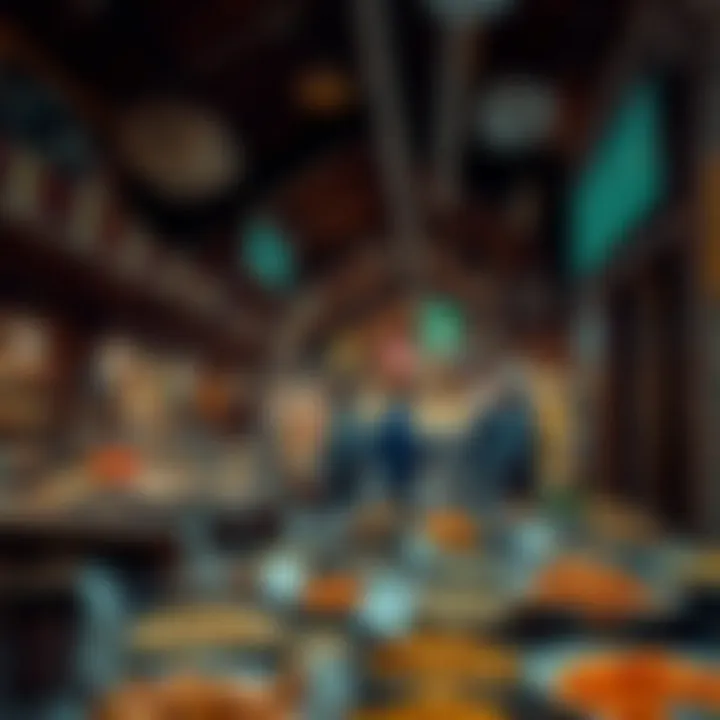
Moreover, the souk provides a platform for traditional festivities. Events such as the Dubai Shopping Festival see the marketplace transform into a hub of cultural expressions, showcasing dance, music, and theater that resonate with both residents and tourists alike. Such experiences facilitate an understanding of Emirati hospitality, welcoming visitors to sample local customs.
A Confluence of Communities
Karama Souk serves as a melting pot where various communities converge. This diversity is palpable—the souk attracts locals from different ethnic backgrounds, as well as tourists from all corners of the globe. Each visit feels distinctly different, influenced by the blend of languages, cuisines, and cultural expressions coexisting within the market's grounds.
The interactions taking place here often transcend mere commerce. They foster cultural dialogues that enrich social ties among diverse populations. For instance, local emirati families frequently mingle with expatriates and tourists, exchanging stories and traditions over shared meals at nearby eateries.
Such gatherings reinforce the notion that while Dubai is rapidly modernizing, the roots and sentiments of the community are still deeply entrenched in tradition. The fluidity of people and ideas in Karama Souk fosters an environment that is rich in cultural significance, connecting the past with the present under the canopy of a bustling marketplace.
Marketplace Dynamics
Karama Souk stands as a vibrant testament to the changing tides of commerce, melding the rich tapestry of tradition with the pulse of modern market practices. This marketplace dynamics section highlights the driving elements, benefits, and considerations that shape the souk's identity as a pivotal trading hub in Dubai.
The values generated through the interactions within exploring the souk's energetically bustling environment are not only monetary; they represent a cultural exchange that balances the old and the new. As more visitors flock to Dubai, the need for unique, authentic shopping experiences grows, sustaining the soul of Karama Souk amidst the encroachments of sleek shopping malls.
Types of Goods and Services Offered
Karama Souk is a veritable treasure trove for discerning shoppers. Among the myriad of goods, buyers can find:
- Handcrafted Artisanship: Local artisans provide an array of traditional crafts, ranging from intricate textiles to stunning ceramics.
- Exotic Spices and Herbs: The piquant aromas wafting through the air entice shoppers, inviting them to dive into culinary explorations.
- Electronics and Clothing: Modern conveniences sit shoulder-to-shoulder with old-fashioned stalls, providing an eclectic mix for every shopper's taste.
In looking for specific, handmade items, shoppers often remark how they stumble upon unique pieces not found in the larger retail chains. It’s these unique finds that truly captivate buyers and keep them returning for more.
Comparison with Other Souks in Dubai
Karama Souk boldly differentiates itself from Dubai’s myriad of other souks. While Spice Souk and Gold Souk shine brightly with their specific offerings, Karama presents a broader spectrum. Here’s how it stacks up:
- Diversity: Karama caters to a wide range of shoppers from various backgrounds, while others can be more niche-focused.
- Accessibility: With its central location and modest prices, it attracts a more varied audience compared to the upscale ambience of the Gold Souk.
- Cultural Experience: Unlike the more commercialized souks, Karama Souk feels lived-in and genuine, showcasing the heart of Dubai’s multicultural fabric.
"While the Gold Souk dazzles with its glittering displays, Karama Souk embraces you with the warmth of its community, where every vendor has a story to tell."
Shopping Experience at Karama Souk
The shopping experience at Karama Souk is not just about acquiring goods; it’s about immersing oneself in a vibrant tapestry of culture and community. Unlike the polished façades of modern malls, Karama Souk pulses with the energy of its diverse shoppers and merchants, creating an atmosphere that is alive with tradition yet blended with modernity. This space has become a melting pot where locals and tourists alike engage in the age-old art of bargaining, exchanging stories as much as goods.
One key benefit of shopping here is the opportunity to discover unique items that carry the essence of Dubai's heritage. From handcrafted jewelry and traditional garments to distinctive souvenirs and intricate art pieces, each stall tells a story. Shoppers can wander through narrow pathways, where the scent of spices mingles with the sound of cheerful banter. It offers a tactile experience that no digital marketplace can replicate. The casual exploration of the souk creates an adventure of its own, a journey where every turn brings a new surprise.
Navigating Through the Souk
Navigating through the Karama Souk can feel like walking through a living history book. The market is designed in a way that encourages exploration; one moment, you might find yourself admiring colorful textiles, and the next, you're discovering local crafts. First-time visitors often find that maps are unnecessary. Instead, it's the sights, sounds, and scents that guide you.
To make the most of your visit, several tips can enhance your shopping journey:
- Take your time: Do not rush. Each shopkeeper has unique stories and items, so leisurely browsing allows for more meaningful interactions.
- Practice your bargaining skills: While the prices can be low, haggling is encouraged and is a part of the shopping culture. It can be a fun way to engage with the sellers.
- Observe your surroundings: Look around to see what other shoppers are drawn to, as this can give you insight into the most popular items.
Preferred Shopping Hours
When planning a trip to Karama Souk, timing can influence your experience greatly. The souk tends to be busier in the evenings, especially as the weather cools down.
Ideal shopping hours include:
- Weekdays: Early afternoon (around 1 PM to 3 PM) is a great time to avoid crowds.
- Weekends: Evenings (after 6 PM) when both locals and tourists flock to enjoy the lively atmosphere.
By selecting your shopping hours wisely, you can enjoy a more relaxed experience or dive into the lively buzz of the evening crowd. At the end of the day, whether you’re a local, an investor scouting opportunities, or a tourist soaking in the atmosphere, the souk has its charm that caters to all.
Culinary Delights
Culinary delights play a pivotal role in shaping the experience at Karama Souk, bringing together a melange of flavors that reflect both the local culture and the diverse community that thrives here. For visitors—whether tourists or long-time residents—these offerings are more than just food; they symbolize a connection to tradition and the wider world. The mouth-watering dishes available at the Souk make it a gastronomic landmark, inviting everyone to taste and discover unique culinary treasures.

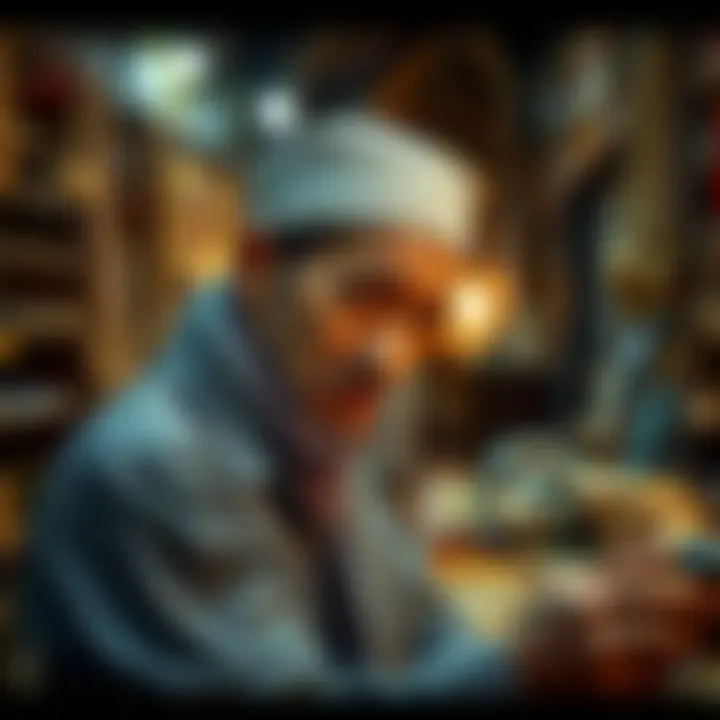
Local Cuisine Offerings
When one takes a stroll through the labyrinthine pathways of Karama Souk, the tantalizing aromas wafting from various stalls are enough to stir up any appetite. Local cuisine offerings range from savory street snacks to traditional meals, with each dish narrating a story and honoring the region's culinary heritage.
One can find unbeatable classics like Shawarma and Falafel, which have earned their place in the hearts of many. Other dishes, like Kebabs and Mandi, showcase the rich flavors of Middle Eastern spices, often cooked to perfection over an open flame. Not to be overlooked, the sweet notes of Baklava and Kunafa complete the experience of savoring local sweets that make a visit here an unforgettable affair.
- Shawarma: A Middle Eastern wrap filled with meat, dressed with tangy sauces.
- Falafel: Deep-fried balls made of ground chickpeas or fava beans, often served in pita bread.
- Kebabs: Skewers of meat grilled over coals, seasoned with aromatic spices.
- Mandi: A traditional rice dish, usually made with chicken or lamb, showcasing the use of saffron and other spices.
The blend of traditional cooking methods with modern twists makes every bite meaningful. One can also find food stalls offering multicultural delights, a nod to the diverse backgrounds found within the community. Through these dishes, patrons can experience the intersection of tradition and contemporary tastes.
Popular Eateries and Cafés
A visit to Karama Souk wouldn’t be complete without stopping at some of its popular eateries and cafés. Whether you’re looking for a quick bite or a leisurely meal, you’ll find an array of choices that cater to varied preferences.
Al-Falah Restaurant is cherished for its authentic Emirati flavors. It’s an ideal place for those wanting to engage with local culture while savoring traditional dishes. Another gem, Karak House, attracts many with its famous Karak tea—a spiced tea that embodies the spirit of conviviality. The menu here offers light snacks and indulgent desserts, perfect for a midday break.
A few noteworthy spots include:
- Al Khaima Restaurant
- Safi Art Café — boasts a uniquely artistic ambiance.
- Chai and Shisha Cafe — where you can unwind while enjoying traditional tea and flavored tobacco.
With an inviting atmosphere and a diverse menu, these establishments do more than just satisfy hunger; they offer a glimpse into the lives and tastes of the people who frequent them. The gathering spaces foster friendships and conversations, making Karama Souk not just a shopping destination but a lively cultural epicenter.
Culinary experiences at Karama Souk are not merely about filling one's belly, but also about feeding the soul and weaving together connections among its visitors.
In essence, Karama Souk's culinary landscape is a testament to the blending of old and new, local and global. This interplay makes it a significant touchpoint in the heart of Dubai, perfect for investors and stakeholders looking to understand community-based dynamics that influence the region.
Tourism and Visitor Insights
Tourism plays a pivotal role in the appeal and vitality of Karama Souk. It stands as a significant destination not just for shopping, but also for soaking in the rich tapestry of culture that Dubai has to offer. The blend of old-world charm and modern attractions draws both locals and visitors, making it an essential stop on any travel itinerary. This section dives into what enhances this shopping haven’s appeal, exploring nearby attractions and an analysis of who is frequenting the souk.
Attractions Nearby
The allure of Karama Souk does not end within its walls. The surrounding area is filled with a treasure trove of attractions that cater to diverse interests. Here’s a taste of what one might find nearby:
- Dubai Frame: This architectural marvel, shaped like a giant picture frame, offers breathtaking views of both old and new Dubai. Visitors can gain insights into the city’s past and future, making it a perfect complement to the experience at Karama Souk.
- Zabeel Park: A green oasis amidst the urban hustle, this spacious park offers plenty of recreational activities. Families can enjoy picnics or leisurely walks, offering a brief respite from shopping.
- Dubai Museum: Located in the historic Al Fahidi Fort a short distance away, this museum provides an in-depth look into Dubai's rich heritage and history. It’s a great way to tie in cultural knowledge with the shopping experience at the souk.
Each of these locations enhances the visitor experience, as they tickle curiosity and provide opportunities for exploration. A day at Karama Souk can easily be extended into an enriching day of cultural learning and enjoyment.
Visitor Demographics
Understanding who visits Karama Souk can give valuable insight, particularly for those invested in its future. The demographics typically lean towards a melting pot of cultures, showcasing the cosmopolitan nature of Dubai. Here are some notable aspects:
- Local Residents: Many Dubai residents, especially from the South Asian community, frequent the souk. They often come for both the unique goods and the sense of community that thrives in the space.
- Tourists: Visitors from Western countries, accompanied by the growing influx from Southeast Asia, form another segment. Many are searching for authentic cultural experiences, which Karama Souk delivers abundantly.
- Expats: This group tends to include young professionals looking for unique finds, from traditional handicrafts to the hidden gems in the culinary scene.
- Families: It’s not uncommon to see families exploring the souk together, indulging in street food and enjoying casual shopping in a warm environment.
These diverse visitor groups contribute to the vibrant atmosphere of the souk, establishing it as a hub for social interaction and community spirit. For investors and stakeholders, recognizing this demographic is essential for tailoring experiences and offerings to match the needs of those who frequent the souk.
Karama Souk serves as a microcosm of Dubai's larger mosaic, highlighting its cultural depth and economic vitality.
Economic Impact
The economic weather around Karama Souk is as dynamic as the marketplace itself. The area not only brims with commerce but also plays a pivotal role in the local economy, serving as a microcosm of Dubai's broader economic landscape. From attracting tourists to supporting local entrepreneurs, Karama Souk's influence is multifaceted. Understanding this economic impact provides valuable insights for investors and stakeholders in the property market, highlighting the area’s relevance in today’s urban ecosystem.
Karama Souk’s Role in Local Economy
Karama Souk operates like a lifeblood for the community. It sustains jobs, fosters entrepreneurship, and provides an affordable shopping space. Vendors offer everything from traditional handicrafts to modern gadgets; it is a place where heritage meets innovation. The foot traffic here is noteworthy, drawing both locals and tourists who are eager to immerse themselves in the cultural experience while contributing to local commerce.
- Job Creation: The souk supports numerous families through various trades, from artisans selling their handmade goods to service providers such as tailors and food vendors. Every transaction forms part of a larger economic rhythm.
- Tourism Revenue: For many visitors, a trip to Karama Souk is a must-do experience where they can shop, eat, and soak in the local culture. This inflow of tourists adds not just economic value but also cultural exchange, enriching the local tapestry.
The surrounding businesses, from cafes to retail shops, also benefit from the souk’s popularity, making it a vital part of the broader economic ecosystem. In short, the souk isn't just a marketplace but an engine powering the economic vitality of the neighborhood.
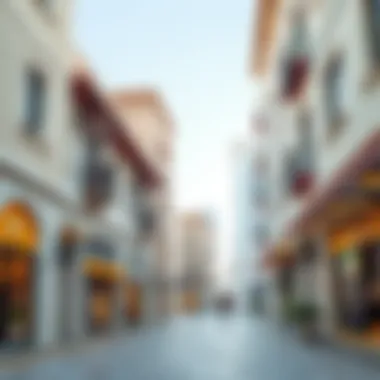

Impact on Real Estate Trends
The economic footprint of Karama Souk extends well beyond its immediate vicinity, influencing the real estate market in significant ways. As the souk continues to thrive, it contributes to an increase in property values in the area, making it an attractive destination for both investors and residents.
- Increased Property Values: As demand for commercial and residential spaces nearby rises, property values are pushed upward. Investors looking at real estate near traditional hubs stand to benefit significantly.
- New Developments: The appeal of Karama Souk often prompts new construction and development projects. For instance, luxury apartments, mixed-use developments, and retail spaces are emerging, serving to meet the growing demand spurred by the souk.
- Attraction of Diverse Populations: As the area enhances its offerings, it also attracts a diverse population looking for both living spaces and commercial endeavors. This influx can stimulate community efforts to further develop the area.
"The enduring popularity of Karama Souk can significantly enhance the attractiveness of surrounding real estate, influencing trends for years to come."
Investors, developers, and potential buyers should take these economic dynamics into account when assessing the long-term viability of properties in the area. The interplay between the tradition represented by the souk and modern real estate development marks a unique opportunity in the urban fabric of Dubai.
Challenges Facing Karama Souk
Karama Souk, while a vibrant space pulsating with life and diversity, is not without its own set of challenges. These issues matter greatly, especially for those keen on understanding the socio-economic landscape of Dubai. They provide insights into how heritage and commerce collide and coexist in this bustling environment. For investors, agents, developers, and managers, grasping these challenges is crucial for informed decision-making, as they directly affect the potential for growth and adaptation in a rapidly changing market.
Preservation of Identity Amid Development
As urbanization sweeps across Dubai, the very fabric of what makes Karama Souk unique is at risk. The souk symbolizes a rich cultural heritage, reflecting the traditions of the local population. Yet, the surge in modern infrastructure often presses against these cultural bastions. There lies a paradox; modernization can boost business but may obliterate the old-world charm that draws both locals and tourists.
The challenge here revolves around balancing new developments while retaining the soul of the souk. Business owners and stakeholders are finding creative ways to preserve authenticity. Some shopkeepers have adopted mixed-use strategies, incorporating new technologies without losing track of their roots. This blend of old and new is paramount, as many long-time patrons seek experiences that echo nostalgia yet fit modern standards.
In light of this, ongoing dialogues among city planners, local artisans, and business owners can be advantageous. Recognizing the cultural significance of the marketplace ensures that any developments align with community sentiments.
Competition from Modern Malls
The rise of gleaming shopping malls in Dubai presents another formidable challenge. These retail behemoths often overshadow local markets like Karama Souk. Shoppers, drawn to their expansive retail options, state-of-the-art amenities, and air-conditioned comfort, may overlook the rich experiences that traditional souks offer.
However, this competition can be seen through another lens. Malls, while appealing, often lack the personal touch and unique offerings that define Karama Souk. It is here that the souk’s vendors can turn the tide—by promoting the unparalleled shopping experiences centered on handmade crafts, engaging narratives behind the products, and personalized services.
Local businesses must adapt and push marketing efforts that highlight what makes them special. Creating collaborations that bring artists and creators into the spotlight could draw visitors back to the soul of the market. Moreover, leveraging social media and local events can help in raising awareness about the unique goods available at Karama Souk, breathing new life into a tradition amid the competition.
The challenges faced by Karama Souk are indeed complex, yet they illuminate the potential for growth and innovation. As stakeholders navigate these waters, the resilience of this cherished marketplace will ultimately determine its future in the landscape of modern Dubai.
"In every challenge lies an opportunity, especially when it comes to blending tradition with the present."
For further insights on topics related to urban development and cultural preservation, the following links might be useful:
Future Prospects for Karama Souk
The vision for the future of Karama Souk is significant, particularly in terms of its role within Dubai’s ever-evolving socio-economic landscape. As the city gears up for ambitious projects and a sustained influx of visitors, there’s an opportunity for Karama Souk to further establish itself as a prime shopping destination. Investing in this area holds notable advantages that can’t be overlooked.
Trends in Consumer Behavior
In recent years, consumer preferences have shifted substantially. Today, shoppers are not just looking for products. They seek experiences. Some of the trends shaping consumer behavior in Karama Souk include:
- Authenticity: More buyers are drawn to traditional handmade items over mass-produced goods. The charm of authenticity resonates with both tourists and locals.
- Digital Influence: With the rise of social media, the way consumers discover products has changed. Visually appealing products that are shared online attract attention. Vendors who optimize their online presence can reap the rewards.
- Sustainability: There's a growing awareness around environmentally-friendly products, compelling businesses to adapt their offerings. Shoppers increasingly appreciate goods that reflect responsible sourcing and ethical practices.
Today’s consumers are looking for more than just a sale. They want a story behind each purchase, a connection to culture, and a reassurance of sustainability.
Investment Opportunities
For investors, the potential in Karama Souk goes beyond selling goods. It's about diversifying into areas that align with modern consumer needs. Consider these opportunities:
- Retail Space Development: As consumer demand evolves, there is room for novel retail spaces that blend tradition with modern amenities. Investors can look into revitalizing existing locations or developing new boutiques that cater to current trends.
- E-commerce Integration: Bridging the gap between physical stores and online shopping can enhance sales. Offering an online platform for local artisans can help reach a larger audience. This presents both logistical challenges and lucrative prospects.
- Culinary Ventures: The appetite for diverse culinary experiences is booming. Opening new eateries that celebrate local flavors or introduce fusion cuisines can attract both tourists and residents.
Culmination
In reflecting on the journey through Karama Souk, it becomes evident that this vibrant marketplace stretches beyond mere transactions; it encapsulates the spirit of a community that thrives on tradition while embracing the influx of modern influences. The importance of Karama Souk to Dubai's cultural tapestry cannot be overstated. It draws together not only residents but also visitors from around the globe, fostering a blend of perspectives that enriches its atmosphere.
One key aspect of the souk’s relevance lies in its diverse offerings. From traditional crafts representing the Emirati heritage to a range of culinary experiences that mirror the confluence of cultures, Karama Souk guarantees something for everyone. This diverse merchandise helps nurture an appreciation for local artistry and gastronomy among consumers. Notably, local artisans find a platform here, ensuring that the heritage crafts continue to thrive against a backdrop of rapid modernization.
Moreover, the souk’s economic importance stands tall amid shiniy modern malls. While newer establishments might draw in a crowd with glitzy charm, Karama Souk offers an authenticity that is often lost in the polished veneer of more contemporary venues. Investors and developers can recognize the potential in such a market that champions not only commerce but also cultural preservation. Understanding the dynamics at play here can provide better insights for those interested in the real estate trends within Dubai.
Therefore, as we synthesize the information gathered, it’s clear that Karama Souk is not simply a shopping destination. It is a living, breathing entity—a symbol of resilience and adaptability, encapsulating the essence of the Dubai experience. Stakeholders must consider the socio-economic dynamics at work within this microcosm of tradition and modernity when strategizing future investments or developments. By engaging with Karama Souk, they aren't just tapping into a market but contributing to a community's vibrant legacy.
"In every nook and cranny of Karama Souk, stories of resilience and tradition await to be discovered."





